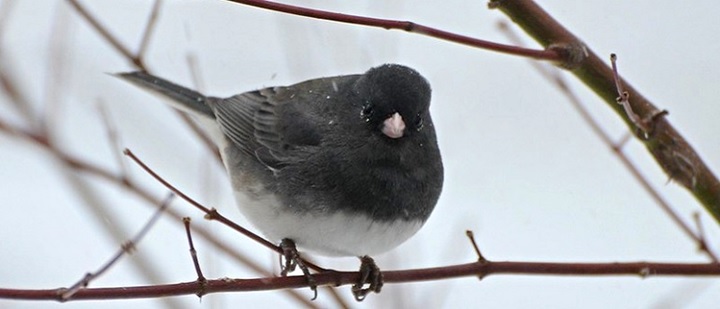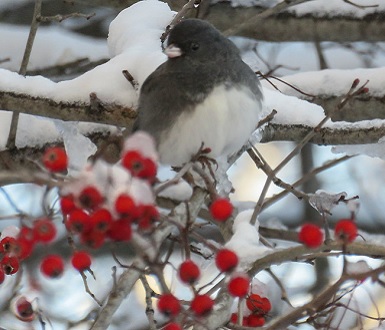Nature’s Original “Snowbird”
GET TO KNOW Dark-eyed juncos
This perky winter visitor was nicknamed America’s “little snowbird” by famed naturalist James Audubon.
Fun Fact: Juncos are one of the most widely studied of all birds, and many researchers believe juncos offer a ringside seat to watch evolution in process. There are significant variations among juncos, and scientists notice relatively rapid changes in response to habitat issues. For example, wildlife experts at the Tennessee Natural Resources Agency have noted evolving differences in wing length within dark-eyed juncos that choose to stay in the Appalachian forests year-round and those that only visit in summer. And biologists at UCLA, who have been studying juncos since the early 1980’s, believe that these little birds can develop significant evolutionary changes within the time frame of only two decades. Needless to say, there is a bit of resulting confusion in the categorization and naming of junco species.
Traveling south from the cold and northern reaches of the continent, dark-eyed juncos overwinter in Michigan backyards, and throughout most of the US, where they gratefully accept offerings of seeds and berries.
Juncos are a type of sparrow, and they often arrive in flocks of mixed sparrow types. While there are several color variations of dark-eyed juncos that may visit western states, only the slate gray juncos are known to visit the eastern half of the country. Among slate gray juncos, males display a handsome plumage of gray and white, while females display a lighter coloring with more shades of brown.
HABITAT AND LIFE CYCLE
Although juncos are often attracted to backyard feeders, they mostly prefer areas that form the edges between woodlands and fields. There, they can search for seeds and insects in the grass and brush while still taking shelter in nearby trees.
During the warmer months of the summer breeding season, when most juncos visit Canada, they feed on insects. However, during winter migration, many juncos come only as far south as our northern states. Still facing a winter of snow and ice, they necessarily switch feeding patterns to eat seeds, grasses, and winter berries.
Prairie dropseed, a lovely native grass, produces tufted seed heads that are also considered a junco winter-time favorite. (Watch for FOTR’s summer native plant sales.)
Throughout the year, juncos maintain a strong social order. Males express dominance over other males for territory rights, and territories – both summer breeding and winter-feeding – are generally established on a “first come / first served” basis according to earliest arrival dates after migration. Therefore, the most aggressive males are inclined to risk early – and short – migrations where they tough out winter in regions that are still cold and frozen. Come spring, they quickly head back north to claim a preferred (and perhaps habitual) breeding space.
Additionally, males express significant dominance over females. During summer breeding, this behavior leads males to defend the female and her nest. However, during winter migration, male juncos are often dangerously dominant over females – even to the point of preventing females from obtaining sufficient amounts of food to survive. Consequently, the females often migrate in separate flocks. And while the males may hang out in the cold year-round, many females will push farther south to find warmer – and safer – winter havens. Come spring, these smart females can take their time moseying back north. (It has also been noted that some dark-eyed juncos stay in the US all year and do not migrate north for summers.)
While juncos are capable of long flights for migration, they seem to prefer engaging in day-to-day activities on the ground. Overall, it appears that most feeding, courting and nesting activities occur on, or near, the ground as these small birds hop busily about. During the breeding season, males court females with a ground-based dance where tail feathers are spread wide to reveal the often-hidden white under-feathers. An interested female may join in the dance, and the two will circle each other with feathers spread wide. Over the course of the season, the pair may then raise 1-3 broods (of 3-6 chicks each) and both parents will participate in the care of fledglings. Nests, built by the female juncos, are often on the ground where they are hidden under brush or logs.
Juncos are fairly small birds (only 5-6 inches long) that often fall prey to larger birds or mammals. Those that escape predators may live relatively long lives. One banded dark-eyed junco was over 11 years old when it was last recorded in West Virginia (per Cornell University’s “All About Birds” site.)
TAKE ACTION
In September 2019, Science Magazine published a study that highlighted an alarming decline of birds across the North American continent. After evaluating results of avian population studies over 48 years, the scientists (lead by Kenneth V. Rosenberg) estimated that total North American bird populations declined by approximately 3 billion birds (29%) between 1970 and 2018. Significant declines were observed within most categories of bird types including “backyard birds.” The study indicates that both habitat loss and climate change were key factors in the declines.
Juncos are among the many birds threatened by the warming effects of climate change. Increased summer temperatures throughout breeding habitats are believed to contribute to higher mortality rates among baby juncos. Additionally, as backyard visitors, juncos are susceptible to window collisions. For information on helping birds avoid window collisions, see the following article at Cornell University’s All About Birds site.
Widespread native tree cover is essential to maintaining our natural, temperate climate. FOTR works with local community organizations to help restore native tree cover as part of our watershed restoration programs. Additionally, as part of our summer native plant sales, FOTR offered prairie dropseed (and other important grasses) plugs for home landscape use. Watch the FOTR store for upcoming spring and summer native plant sales this year.
MAIN PHOTO CREDIT: Male Dark-eyed Junco (Junco hyemalis) by Andy Reago & Chrissy McClarren -CC-BY-2.0 – image cropped

